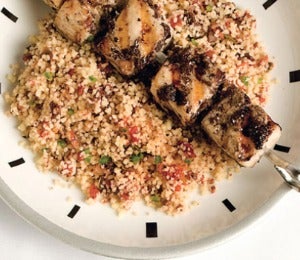

Growing up in lowland North Carolina, I never had many side dishes except greens, macaroni and cheese, beans or potatoes. But there was one side dish that I hated the most, and that was rice. Oh, my goodness! We had rice almost every day of the week. It was oftentimes lumpy, sticky, al dente or just bland! It was a staple in my family and for others, and I understood why: it was inexpensive and you could feed your family for a few days.
If we did not have a pot of rice cooking on the stove, the meal seemed incomplete. I even boycotted a few times, but food left on my plate had to be eaten or I could not leave the table. So I became innovative, hiding it in the crevices of my biscuit or dumping it in the trash once my mother left the room.
When I entered adulthood, I decided to take my fate into my own hands and started eating a little healthier. One day, while shopping in Publix, I strolled down the ethnic and health food aisle and discovered a box of instant couscous. Not sure of how to even prepare it, I purchased it anyway. I thought if I could cook grits, I could surely cook couscous. Not only was it easy to prepare but it tasted amazingly delicious! I found myself eating it out of the pot in the middle of my kitchen.
Originating in Northern Africa, the dish is a traditional staple food throughout much of West Africa, Spain, India, the Middle East, many Mediterranean countries and other parts of the world as well. Couscous is usually made from either semolina (coarsely ground durum wheat) or coarsely ground barley or pearl millet. Considered one of the healthiest grain-based products on the market today, it has a glycemic load lower than that of any pasta and contains twice as much riboflavin, niacin, vitamin B6, and folate, and four times as much thiamine and pantothenic acid. Served under a meat or vegetable stew, it can also be eaten alone, flavored or plain, warm and even cold.
There are a number of ways to prepare couscous but the more common is in a couscoussiere, which is a traditional tall, metal steamer or on the stove top. In the Western world, the supermarket variety has been pre-steamed, pre-flavored and dried, with little to no cook time. The package directions usually asks for a specific amount of boiling water or stock, butter or olive oil and asks for the pot is to be covered tightly for 5 minutes. Within a few minutes it is done; just fluff with a fork and serve.
Properly cooked couscous should be light and fluffy, and not too wet. I am partial to this methodology, due to less prep time than regular couscous, dried pastas and dried grains. There is no proper way to eat couscous. I have seen and had it with vegetables, raisins, nuts, dried fruits, cooked in a broth and served with chicken, lamb and even beef.
Another way to consume couscous is at the end of a meal as dessert. In Morocco, it is often prepared with dates, sesame, and pure honey, and known as “maghrood.” In Egypt, a pat of butter, a sprinkle of sugar, and cup of cinnamon, raisins and nuts are combined with the grain and topped with cream. Another suggestion would be to sprinkle with almonds, sugar and flower water and eat out of a bowl like a cold soup. Think of it as a sweet porridge.
So the next time you’re searching for a side dish substitute, consider couscous. It’s not your mama’s rice, but couscous proved to be a great replacement. Try our featured recipe, listed below, and let us know your thoughts. Cheers!
Mahi-Mahi Skewers with Tapenade and Couscous
Ingredients
1 cup plain couscous (about 6 ounces)
1 teaspoon coarse kosher salt, divided
1/3 cup purchased tapenade
3 tablespoons fresh lemon juice
1 teaspoon freshly ground black pepper
1 pound mahi-mahi fillets, cut into 1-inch cubes
1 cup purchased pico de gallo, drained
SPECIAL EQUIPMENT
Metal skewers
Preparation
Preheat broiler. Bring 1 cup plus 2 tablespoons water to boil in heavy medium saucepan. Stir in couscous and 1/2 teaspoon coarse salt. Remove from heat. Cover and let stand until water is absorbed and couscous is tender, about 10 minutes.
Meanwhile, stir tapenade, lemon juice, 1 teaspoon pepper, and 1/2 teaspoon coarse salt in small bowl to blend. Transfer 31/2 tablespoons tapenade mixture to another small bowl and reserve for couscous.
Thread fish pieces onto 4 metal skewers; arrange on broiler tray. Brush fish on both sides with remaining tapenade mixture. Broil fish until just opaque in center, about 4 minutes per side.
Fluff couscous with fork. Gently stir in reserved tapenade mixture. Stir in pico de gallo or serve it alongside. Mound couscous on plates. Top with fish skewers.
Recipe courtesy of Bonappetit.com.
